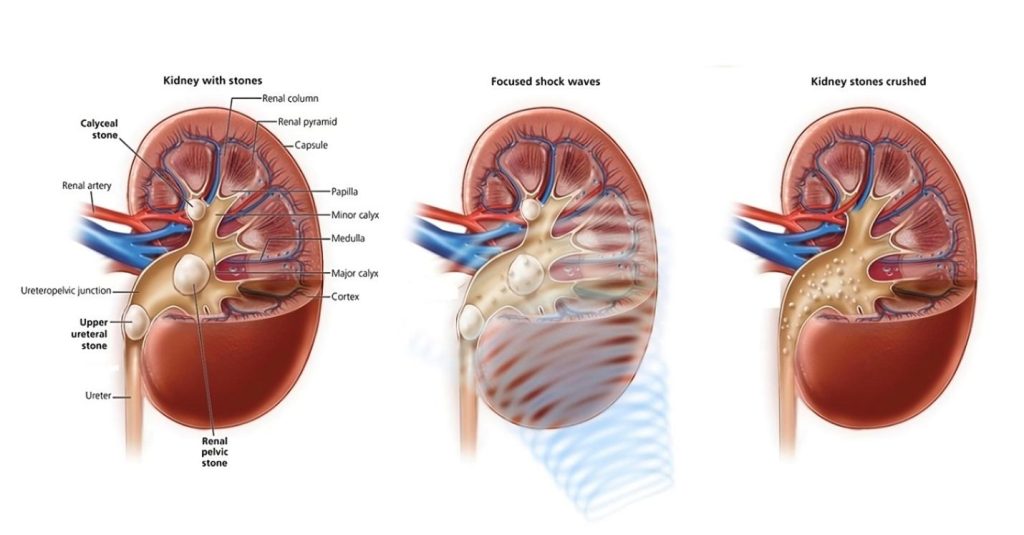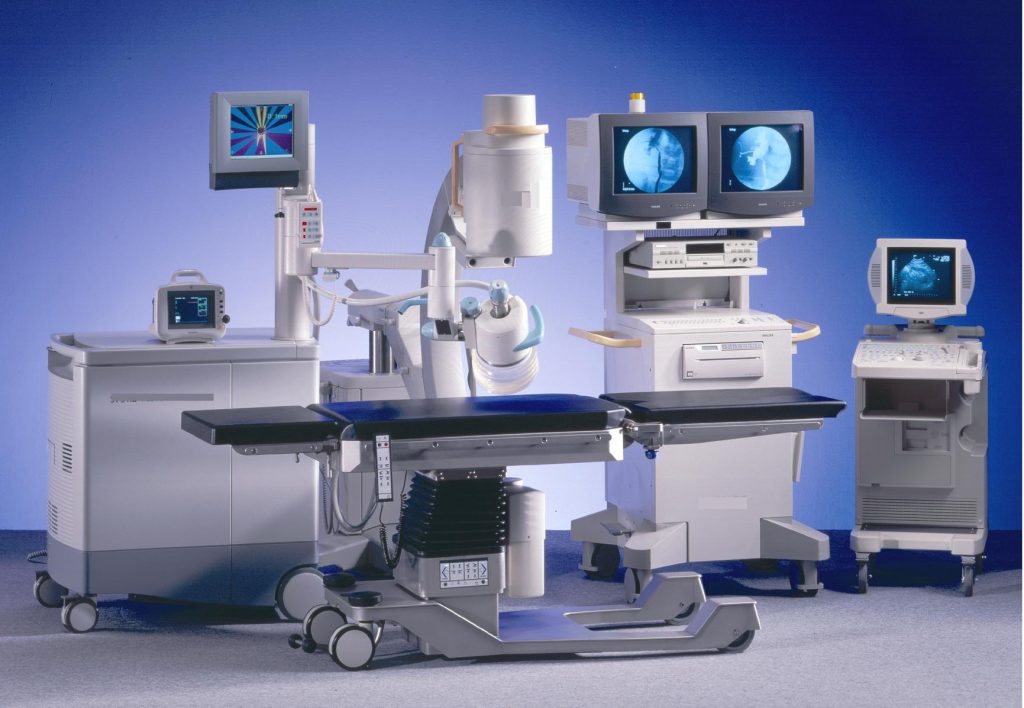Each year, lots of people all over the world suffer from kidney stones, which are hard masses of crystallized substance that form in their kidneys. While some stones travel through the urinary canal by itself, others can cause severe discomfort, obstruction, or other difficulties needing medical care. Extracorporeal Shock Wave Lithotripsy (ESWL) is a typical non-intrusive procedure for eliminating kidney stones. This method uses powerful impact waves to break down big stones into smaller fragments, making it easier for the body to pass them.
In this article, we will go over the ESWL process in detail, including the benefits, possible dangers, and time needed for recovery. This will help you understand why ESWL is the chosen treatment choice for many people with kidney stones.
What is Extracorporeal Shock Wave Lithotripsy (ESWL)?
Extracorporeal Shock Wave Lithotripsy (ESWL) is a non-invasive procedure that uses waves of shock for treating kidney stones, ureteral stones, and bladder stones. The word “extracorporeal” means “outside the body,” referring to the point that the procedure involves no cuts or internal surgical methods. Rather, shock waves are produced outside of the body and targeted at the stones. These shock waves penetrate the layers of skin and tissues, delivering high-energy pulses that reduce the stones to powder form or smaller fragments. Once broken into smaller pieces, the stones can be carried easily through the urinary tract and naturally expelled from the body.

How Does Extracorporeal Shock Wave Lithotripsy (ESWL) Work?
1. Preparation:
Mild sedation is usually administered to keep the patient secure and free of discomfort during the procedure itself. General anesthesia might be essential in specific situations, based on the health of the individual and the size and position of the kidney stones. To enhance shock wave transmission, a particular gel will be applied to the skin overlying the kidneys.
2. Shock Wave Generation:
A lithotripter is a device that produces shock waves. This device transmits high-powered sound waves that are perfectly focused on the kidney stones. This is achieved by using a visual device, such as ultrasound or X-rays, to accurately identify the stone.
3. Destroying the Stones:
The lithotripter powders or breaks the kidney stones into smaller fragments with the help of high-energy shock waves, which are focused and directed towards them. The time for the process depends upon the hardness and size of the kidney stones. Since the shock waves penetrate the skin and tissues without causing any damage, ESWL treatment is considered non-invasive.
4. Post-Procedure
After the stone is powdered, the body can pass the little bits via the urinary system less easily. Patients are often advised to drink plenty of water to help drain the stone fragments from their kidneys and ureters. Some patients may also be given medications that relieve any discomfort or pain they experience as the stone fragments move through the urinary tract.

Benefits of Extracorporeal Shock Wave Lithotripsy (ESWL)
| ESWL | Other Procedures | |
|---|---|---|
| Cuts & Scars | Maybe | |
| Anesthesia | No (Adults) | |
| Blood Loss | ||
| Infection | ||
| Recovery Period | Sameday | Upto a Week |
| Hospitalization | ||
| Technology | Very Advanced | Primitive to Advance |
| Procedure | Almost Painless | Painful |
ESWL has several significant advantages as compared to usual surgical procedures for kidney stone treatment, such as
1. Minimum pain
While the process may feel uncomfortable, it generally feels much less painful than passing a kidney stone or having invasive surgery. Local anesthesia or mild sedation is enough to keep patients comfortable throughout this procedure. Furthermore, ESWL is less painful after treatment than more painful surgeries.
2. Fast Recovery and Fewer Side Effects
Most people report comparatively minor side effects after ESWL, such as moderate soreness or bruising where the shock waves were applied. Patients are usually able to resume normal activities within a few days. Recovery period is much less than for surgery or other invasive procedures.
3. Lower Risk of Complications
Because ESWL is non-invasive, the chance of serious problems, such as infection, bleeding, or organ damage, is low. As a result, it is regarded as a relatively safe alternative for many people, including those with underlying medical issues that may make surgery more dangerous.
4. Outpatient Procedure
ESWL is an outpatient procedure, which means that patients can usually go home the very same day after getting treatment. This is a significant advantage over other invasive procedures, which require hospitalisation and extended recovery durations.
5. Non-Invasive Treatment
One of the most significant advantages of ESWL is that it is a noninvasive therapy. Unlike conventional surgery, no punctures or cuts are made on the body. This drastically decreases the risk of challenges, infections, and lengthier recovery periods. The shock waves are harmless to the surrounding tissues, thus making it the most preferred treatment for kidney stones.
6. Minimum Procedural Time
ESWL is a relatively short procedure. The whole procedure takes between 30 and 45 minutes. Patients often spend only a few hours at the medical center, making it a perfect choice for people with hectic lives or who prefer to avoid lengthy stays in the hospital.
7. High Success Rate
ESWL offers a high success rate, particularly with small stones. It successfully treats stones ranging in size from 10mm to 20mm in diameter. Huge stones can be addressed with ESWL; however, multiple treatments may be required in some cases. In many cases, patients experience significant improvements after a single session.
Who can opt for ESWL?
ESWL is most successful for patients who have kidney stones and meet particular conditions. The most appropriate candidates for this kind of procedure are:
Stone Location: Stones in the kidneys or upper section of the ureter are typically easier to treat with ESWL. Shock waves may be less useful for treating stones in the lower ureter.
Stone Size: ESWL is often advised for stones with diameters ranging from 5 mm to 20 mm. Stones greater than 20 mm may necessitate numerous treatments or other procedures such as ureteroscopy or percutaneous nephrolithotomy (PCNL).
Stone Composition: ESWL is more successful for calcium oxalate or uric acid stones, which are more prone to fragmentation with shock waves. Cystine and struvite stones, which are tougher to break, may necessitate additional treatment choices.
Overall Health: ESWL is appropriate for people in excellent health with no contraindications such as blood coagulation problems or active urinary tract infections. Because ESWL uses shock waves, pregnant women and individuals with specific heart issues may be ineligible.
Complications and Risks of ESWL
While ESWL is usually regarded as safe, it, like any other medical technique, is not without dangers. Possible complications include:
Pain and Discomfort: Some people feel pain as the stone shards move through their urinary tract. This is typically transient and can be treated with pain medication.
Bleeding: A small amount of blood in urine (haematuria) is a common side effect of ESWL. This is usually transitory and resolves on its own.
Infection: Although uncommon, an infection in the kidneys or bladder may occur after treatment, especially if there is a big stone or any remaining stone fragments.
Incomplete Stone Fragmentation: In some cases, the shock waves may not break the stone into small enough pieces, or some pieces may remain lodged in the urinary tract. This may require additional treatments or procedures.
Kidney Damage: Although uncommon, ESWL can injure the kidneys or surrounding tissues, especially if the stone is in a hard-to-reach area.
Obstruction: If the stone fragments are too big to move through the urinary tract, they may get lodged and cause a blockage. This may necessitate additional intervention.
Recovery after ESWL
The recovery phase after ESWL is usually quick, with most patients able to resume regular tasks in a few days. To promote a smooth recovery, patients should adhere to the following guidelines:
1. Follow-up Appointments: Patients will usually have a follow-up session with their doctor to check on the progress of stone passage and ensure that no more treatments are required.
2. Hydration: Drinking enough of water helps to flush the stone fragments from the urinary system. This can assist to lower the chance of obstruction and pain.
3. Activity Restrictions: While most patients may resume reqular activities in a few days, it is best to avoid heavy lifting and intense exercise for the first week or so.
4. Pain Management: Some people may feel discomfort as the stone particles move through their urinary tract. Without a prescription pain medications, such as ibuprofen or acetaminophen, are usually enough to treat symptoms.
Conclusion
Extracorporeal Shock Wave Lithotripsy (ESWL) provides highly effective, non-invasive procedure to treat urinary stones that has several benefits, including a short healing period, a high rate of success, and a minimal risk of complications. For individuals struggling with kidney stones, ESWL is a secure and easy choice, especially for those with tiny stones in the kidneys or upper ureter.
Although ESWL is not for everyone, it is still one of the most popular and efficient ways to treat kidney stones. As with any medical operation, ESWL should be discussed with a healthcare provider to evaluate whether it is the best option depending on the size, location, and composition of the stones, as well as the patient’s overall health.If you or a loved one are struggling with kidney stones, consider speaking with a urologist to learn more about ESWL and other treatment options that could help you achieve relief.
To summarize, Urosonic is committed to providing modern, patient-friendly kidney stone cures involving ESWL (Extracorporeal Shock Wave Lithotripsy). This painless surgery requires no anesthesia and is practically painless, allowing patients to receive successful kidney stone removal without the stress of traditional surgery. At Urosonic, we put your comfort and recovery first, providing the best care possible through cutting-edge, minimally invasive therapies. If you’re looking for a dependable and easy choice for kidney stone surgery, ESWL could be the answer.
